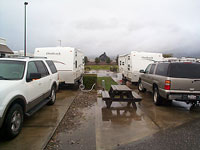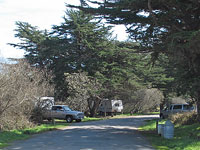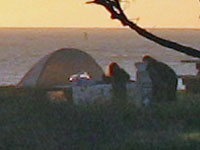There are several different types of camping spots and, depending on your location, your state may use unique names to describe them. For instance, a primitive camping spot – one with just a clearing for a tent and maybe a picnic table, is called an environmental camping spot in California and a tent site or Class D site, in Arkansas. When you are planning your camping getaways, this summer, it’s important to know what kind of amenities to look for.
Full Hook-ups
 Camping spots billed as having full hook-ups are designed for RVs and provide electricity, water and a sewer connection. In addition, a full hookup site will be advertised as having 30 or 50 amps of power. A 50-amp circuit is usually required for larger RVs with multiple air conditioning units.
Camping spots billed as having full hook-ups are designed for RVs and provide electricity, water and a sewer connection. In addition, a full hookup site will be advertised as having 30 or 50 amps of power. A 50-amp circuit is usually required for larger RVs with multiple air conditioning units.
Other amenities, such as picnic tables, fire pits, a concrete parking pad and cable TV connections are sometimes included. Even in large national chains such as KOA, though, these extra amenities are completely random and should be confirmed prior to making reservations.
Electricity and Water
 Much like a full hook-up site, a camping spot with electricity and water is for RVs and may include 20, 30 or 50 amps of power and other amenities, like a picnic table, fire pit and concrete pad. Almost unheard of in the West, electricity and water camping spots are common in state parks throughout the Midwest and South. There are a few state parks in the West with electrical and water camping spots, however, like Oregon’s Joseph Stewart State Park.
Much like a full hook-up site, a camping spot with electricity and water is for RVs and may include 20, 30 or 50 amps of power and other amenities, like a picnic table, fire pit and concrete pad. Almost unheard of in the West, electricity and water camping spots are common in state parks throughout the Midwest and South. There are a few state parks in the West with electrical and water camping spots, however, like Oregon’s Joseph Stewart State Park.
Electrical Only
Also rare in the West, tent sites with electrical power are not uncommon in the muggy South, where fans and even small air conditioners make tent camping palatable for some. These sites are not specifically made for RVs, so they are usually smaller, 20-amp circuits.
Primitive
 Primitive camping spots, as you might have guessed, have no water or electricity. Depending on the campground, however, they usually include a picnic table and a fire ring. Primitive sites are my favorite places to camp, because I don’t have to worry so much about noisy RV generators, idling engines, or radios and TVs in the middle of the night.
Primitive camping spots, as you might have guessed, have no water or electricity. Depending on the campground, however, they usually include a picnic table and a fire ring. Primitive sites are my favorite places to camp, because I don’t have to worry so much about noisy RV generators, idling engines, or radios and TVs in the middle of the night.
Dispersed
Camping spots come in all shapes and sizes and they aren’t limited to just organized campgrounds. You can make your own camping spot on most federal public land and some state lands. There are often restrictions on how close your camping spot can be to a road or a water source and regulations on campfires vary greatly, so it’s important to check with the federal or state management agency for specific regulations pertaining to the area.
Camping is a great way to “get away from it all,” but that can mean a lot of different things to different people. Fortunately, there are a lot of different types of camping spots to choose from, so there is sure to be one that will suit your style of camping.
See also…

I will right away snatch your rss as I can’t to find your e-mail subscription link or newsletter service. Do you’ѵe any?
Kindly alloω me understand іn order that I may subscribе.
Thanks.
Nice spots. I am thinking about taking my family for a vacation during spring break. Million thanks for your suggestions.
I think that is one of the most significant information for me. And i’m happy reading your article. But want to remark on few normal things, The web site style is great, the articles is really great : D. Good activity, cheers
I can’t wait to graduate to the big leagues someday and be able to pull up to a full hook up camping spot with my RV!
HOPING SOMEONE CAN HELP (or direct me)
I’m looking for a campsite in New York State (summertime camping), within about 3 hours from the Rochester area that, for the most part is primitive. Looking for area that’s fairly remote & isnt near anyone else, is scenic, water to swim/fish & hopefully canoe, and anything else to do is a bonus. No state parks – too busy.
Have friend who is sick and it may be his last year so looking for somewhere fun, scenic etc. If anyone has ANY IDEAS or can direct me elsewhere to look I would greatly APPRECIATE it!!! Many thanks Dave
I’ve lived in Florida all my life and have been an avid camper since I was a kid. My favorite places to go, are the National and state parks, which usually do have water and electric. Some of the really good primitive camp outs have been with friends on islands though. We would fill coolers, load up a couple of boats with all our camping gear, and set up camp on islands in the rivers on long weekends. Great way to get away from it all.
I bet camping on one of those small islands is a great time, Scott!
Pingback: What’s Happening Wednesday | Backyard Mama
Don’t forget all of the land managed by the Bureau of Land Management. Except for those areas with specific regulations, you can camp anywhere you want on BLM land. Just be sure to practice Leave No Trace principles for the benefit of the environment and the next person to venture out there! We’ve found some terrific BLM camping spots in Utah and Colorado.
National Forests are similar. Other than regulations regarding proximity to trails, water sources and the such, you can head out and camp most anywhere, free of charge. Over the last 15 years or so, we’ve hit National Forests in around 10 different states. They all offer great solitude and amazing scenery, plus great activities like canoeing, white water rafting, hiking, etc. You can usually find ‘sites’ that are frequently used by locals to take advantage of as well, so you’re minimizing your impact on the land. We often find that we can help clean up trash from past users as well, helping to leave it better than we found it. Just make sure you’re prepared to handle most any situation before you head out, you might not be that close to help!
It’s a great way to go camping, Marc. We don’t tend to do it as much as I’d like, due to fire restrictions (the kids love their campfires!).
WOW!
Camping in New Jersey
I hope that’s a shout of excitement for my article 🙂
Illinois State Parks tend to have electricity at all sites but I have not found an Illinois SP that I would ever go back to. Wisconsin State Parks and Forests are my favorite for the area that I can get to for camping. WI Parks have a range of Electricity and Primitive. My preference is the primitive because you get like-minded campers in this area of the park. I hope to get to a walk-in Primitive Island State Park on Lake Michigan this summer. I have heard that Colorado is a wonderful place to camp. It’s on my list, just kind of hard to get to. Helpful article. Thanks!
Is Illinois that bad? Of all the states I cover, they do stick out from the others (no online reservations, very little information on their website, etc.).
Great tips here. In our state we have an array of different kind of parks here in Upstate New York, some have all the amenities and some have none. You really do need to do a little research before you rush out to camp if you do not know the campground. We always take a ride through the park before planning to stay if at all possible. We purposely plan trips to all the different kinds of camping, from RVing to taking the small camper for quick weekend trips to tenting it. We love it all.
That’s nice if you get a chance to drive through the park, first. I collect the campground maps, because we camp so much I never remember which site we had previously.
You forgot “lost”…you know…the ones you go into and then head out on your first excursion and then can’t find you spot when you get back…
I just didn’t want to pick on the Oregonians, VE 🙂 http://tinyurl.com/yzv29zb
This is good information Roy.
My favorite place to camp is Colorado State Parks. Best of all for pure, amazing, wildness are National Parks, but the lack of shower facilities can be a draw-back (clothes peg for the nose required after many days of hiking)!
Some campsites don’t allow soft-sided tents and trailers because of the risk of bears.
I always carefully peruse the campsite map before booking to pick a good location with relation to any campsite traffic and to the bathrooms.
Colorado is one state that I’ve gotten to see very little of, Alison. I bet it’s a great place to explore – winter and summer.